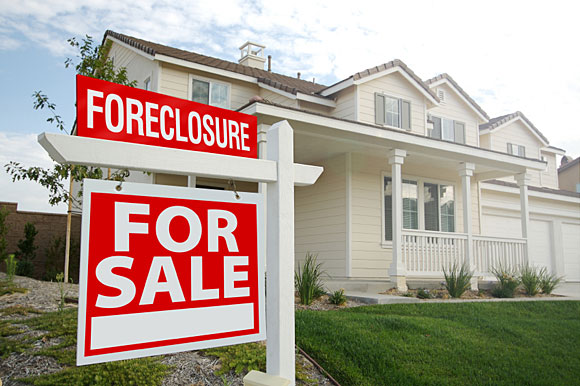Residential real estate prices fell more than forecast in November, showing distressed properties are hampering improvement in the U.S. housing market.
The S&P/Case-Shiller index of property values in 20 cities declined 3.7 percent from November 2010 after decreasing 3.4 percent in the year ended in October, the group said today in New York. Economists projected a 3.3 percent drop, according to the median estimate in a Bloomberg News survey.
Another wave of foreclosures threatens to keep the pressure on prices and delay recovery in the industry that precipitated the last recession, underscoring the Federal Reserve's view that housing “remains depressed.” More stability in real-estate values may be needed to persuade Americans to take advantage of record-low mortgage rates.
“We've seen home prices take a turn for the worse after showing some signs of a bottom, and we do think that there is more downside from here,” said Ellen Zentner, a senior economist at Nomura Securities International Inc. in New York, who correctly forecast the price decline. “If you get stronger jobs and wage growth, it'll go far in alleviating some of the pipeline foreclosures that have yet to happen.”
Stock-index futures held gains after the figures. The contract on the Standard & Poor's 500 Index maturing in March rose 0.5 percent to 1,315.7 at 9:22 a.m. in New York.
Estimates for the price change ranged from declines of 3.9 percent to 2 percent, according to the forecasts of 30 economists in the Bloomberg survey. The Case-Shiller index is based on a three-month average, which means the November data was influenced by transactions in September and October.
RELATED ITEM States with the lowest property taxes »
Home prices adjusted for seasonal variations fell 0.7 percent in November, matching the drop in October. Unadjusted prices declined 1.3 from October as 19 of 20 cities showed declines. Phoenix posted a 0.6 percent gain from October.
The year-over-year gauge provides better indications of trends in prices, according to the S&P/Case-Shiller group. The panel includes Karl Case and Robert Shiller, the economists who created the index.
Eighteen of the 20 cities in the index showed a year-over- year decline, led by an 11.8 percent slump in Atlanta and a 9.1 percent decrease in Las Vegas.
Detroit showed the biggest year-over-year increase, with prices rising 3.8 percent in the 12 months to November. The other gain was in Washington, where prices climbed 0.5 percent from November 2010.
RELATED ITEM States with the heftiest property taxes »
“Despite continued low interest rates and better real GDP growth in the fourth quarter, home prices continue to fall,” David Blitzer, chairman of the S&P index committee, said in a statement. “The trend is down and there are few, if any, signs in the numbers that a turning point is close at hand.”
Historically low mortgage rates have failed to revive housing sales above their pre-recession peak. The average 30- year fixed rate mortgage was 3.98 percent as of Jan. 26, according to a Freddie Mac index. The index reached the lowest level in 40 years on Jan. 19, when rates fell to 3.88 percent.
A rebound in the inventory of unsold homes may hinder progress. Banks may seize more than 1 million U.S. homes this year after legal scrutiny of foreclosure practices slowed actions against delinquent property owners in 2011, RealtyTrac Inc., an Irvine, California-based data seller, said Jan. 12.
“Lending standards and demand for loans to purchase residential real estate were reportedly little changed” in the fourth quarter from the prior three-month period, the Fed said yesterday. The Fed surveyed loan officers at 56 domestic banks and 23 U.S. branches and agencies of foreign banks between Dec. 21 and Jan. 10.
Fed on Housing
Fed officials, at the conclusion of their Jan. 24-25 policy meeting, said the “housing sector remains depressed,” a reason for their decision to keep interest rates low until 2014.
At the same time, falling joblessness and rising incomes have made Americans more optimistic, which may provide the demand needed to stabilize prices. In December, the unemployment rate fell to an almost three-year low of 8.5 percent, Labor Department figures showed Jan. 6. Personal incomes climbed 0.5 percent last month, the most since March, the Commerce Department said yesterday.
Builders have become more upbeat about the housing market. The National Association of Home Builders/Wells Fargo sentiment index rose this month to the highest level since June 2007 as sales and buyer traffic improved.
Economic Signs
“We turn our attention to the spring selling season with a renewed sense of optimism, not only because of our own improving trends but also because of the favorable signs we see in the economy, new and existing home level inventory, employment, affordability and consumer confidence as it impacts our business,” Larry T. Nicholson, chief executive officer of Ryland Group Inc. (RYL), said during a Jan. 27 conference call.
The Westlake Village, California-based company builds homes with an average price of $255,000 in 13 states. Orders climbed 24 percent at Ryland in the fourth quarter from the same three months a year earlier.
--Bloomberg News







